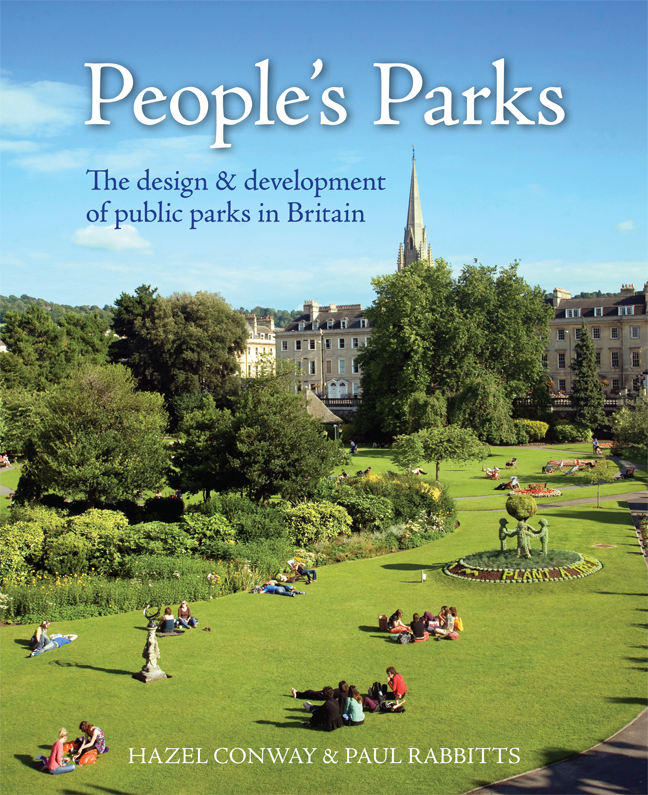Book contents
- Frontmatter
- Dedication
- Contents
- Miscellaneous Frontmatter
- Preface
- Acknowledgements
- Foreword
- A Word from Parks Professionals, Politicians and Parks Organisations
- Introduction: Dr Hazel Conway (1991)
- 1 Public Parks and Municipal Parks
- 2 The Need for Parks
- 3 Pioneering Parks Development
- 4 The Park Movement
- 5 Design and Designers
- 6 Lodges, Bandstands and the Cultivation of Virtue
- 7 Local Pride and Patriotism
- 8 Planting and Park Maintenance
- 9 Permitted Pastimes
- 10 Recreation Grounds, Parks and the Urban Environment
- 11 Public Parks, 1885–1914
- 12 Later Municipal Park Designers
- 13 Garden Cities and the New Towns Movement
- 14 Sport, Physical Activity and Recreation in Public Parks in the Inter-war Years
- 15 Parks Management – a Changing Perspective
- 16 Decline, Revival and Renewal – the Role of Parks into 21st-century Britain
- Appendix 1 Summary of main legislation promoting early park development
- Appendix 2 Chronology of main municipal and public park developments between 1800 and 1885
- Notes
- Bibliography
- Subscription List
- Index
Preface
Published online by Cambridge University Press: 22 February 2024
- Frontmatter
- Dedication
- Contents
- Miscellaneous Frontmatter
- Preface
- Acknowledgements
- Foreword
- A Word from Parks Professionals, Politicians and Parks Organisations
- Introduction: Dr Hazel Conway (1991)
- 1 Public Parks and Municipal Parks
- 2 The Need for Parks
- 3 Pioneering Parks Development
- 4 The Park Movement
- 5 Design and Designers
- 6 Lodges, Bandstands and the Cultivation of Virtue
- 7 Local Pride and Patriotism
- 8 Planting and Park Maintenance
- 9 Permitted Pastimes
- 10 Recreation Grounds, Parks and the Urban Environment
- 11 Public Parks, 1885–1914
- 12 Later Municipal Park Designers
- 13 Garden Cities and the New Towns Movement
- 14 Sport, Physical Activity and Recreation in Public Parks in the Inter-war Years
- 15 Parks Management – a Changing Perspective
- 16 Decline, Revival and Renewal – the Role of Parks into 21st-century Britain
- Appendix 1 Summary of main legislation promoting early park development
- Appendix 2 Chronology of main municipal and public park developments between 1800 and 1885
- Notes
- Bibliography
- Subscription List
- Index
Summary
This book, formerly People's Parks: The Design and Development of Victorian Parks in Britain, was written in 1991 by Dr Hazel Conway, and identified the main national and international influences on park development from the 19th century in Britain, relating them to the design and use of municipal and other public parks. Municipal parks made an important contribution to the urban environment and they developed within a social, economic and political context which affected people's attitudes to recreation. The promoters of parks wanted to encourage education and particular forms of recreation, and parks reflected this in their design, buildings, statues, bandstands and planting.
In 2022, the opportunity arose to update Hazel's book, with permission from her daughter, Zara, as Hazel had passed away in December 2017. Since it was originally published by Cambridge University Press in 1991, further research work has evolved over the last 30 years, in particular by Harriet Jordan, David Lambert, Katy Layton-Jones, Carole O’Reilly, Paul Rabbitts, Historic England, the Association of Public Service Excellence, the Heritage Fund and many other parks historians, and it was decided not only to update the book, but to add new chapters to it, covering garden cities and the new towns movement; the impact of sport and physical activity in public parks, in particular during the war and inter-war years; post-war Britain and the gradual changes in recreation; the changing perspectives in parks management; decline and social upheaval; revival and renewal; and finally the role of public parks in the 21st century, taking into account the global pandemic of COVID-19 and how it renewed our interest in people's parks. This update could not have come at a better time as public parks face fresh austerity post-COVID-19, aligned with their increase in popularity and the climate crisis we face.
- Type
- Chapter
- Information
- People's ParksThe design & development of public parks in Britain, pp. ixPublisher: Boydell & BrewerPrint publication year: 2023

